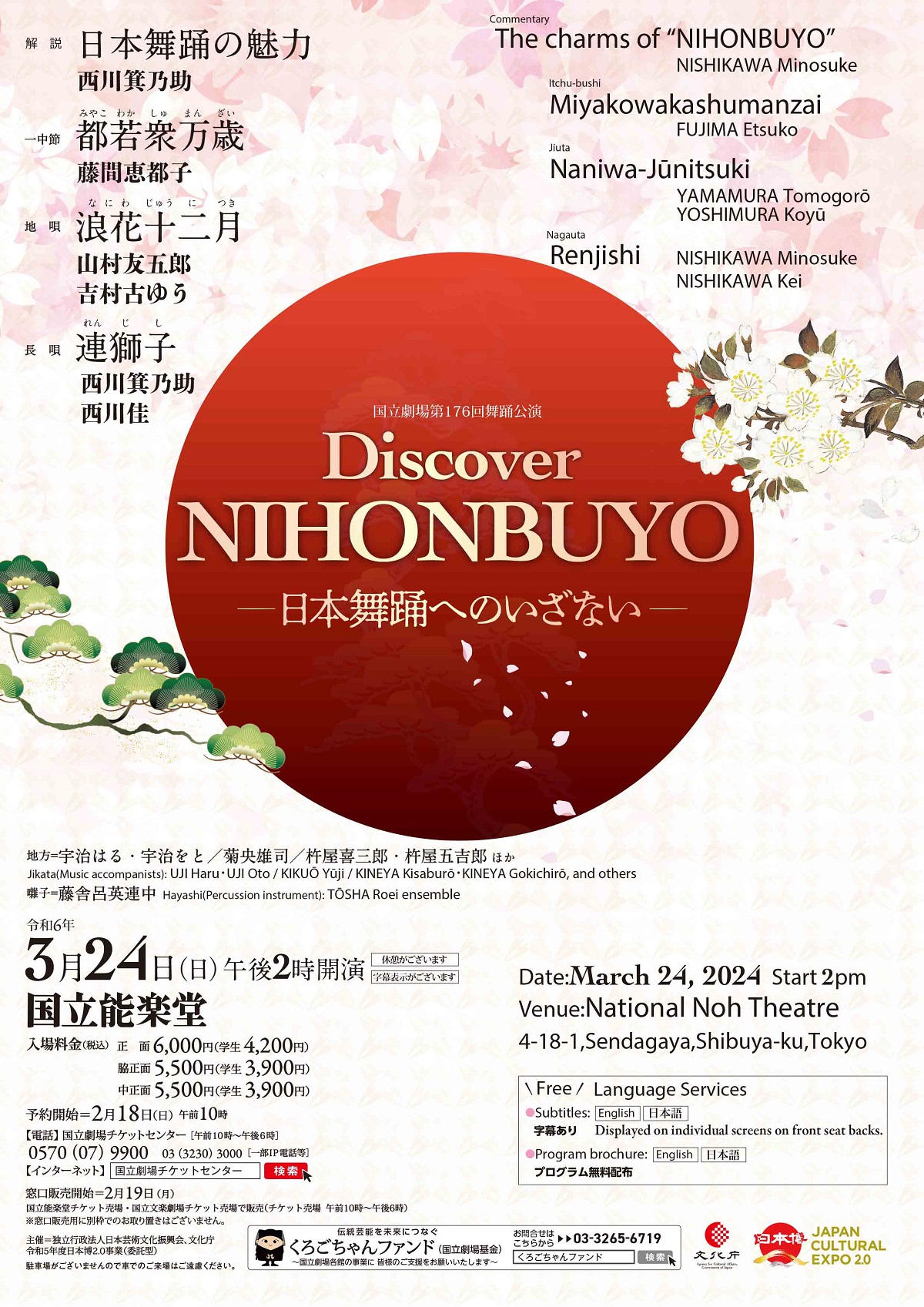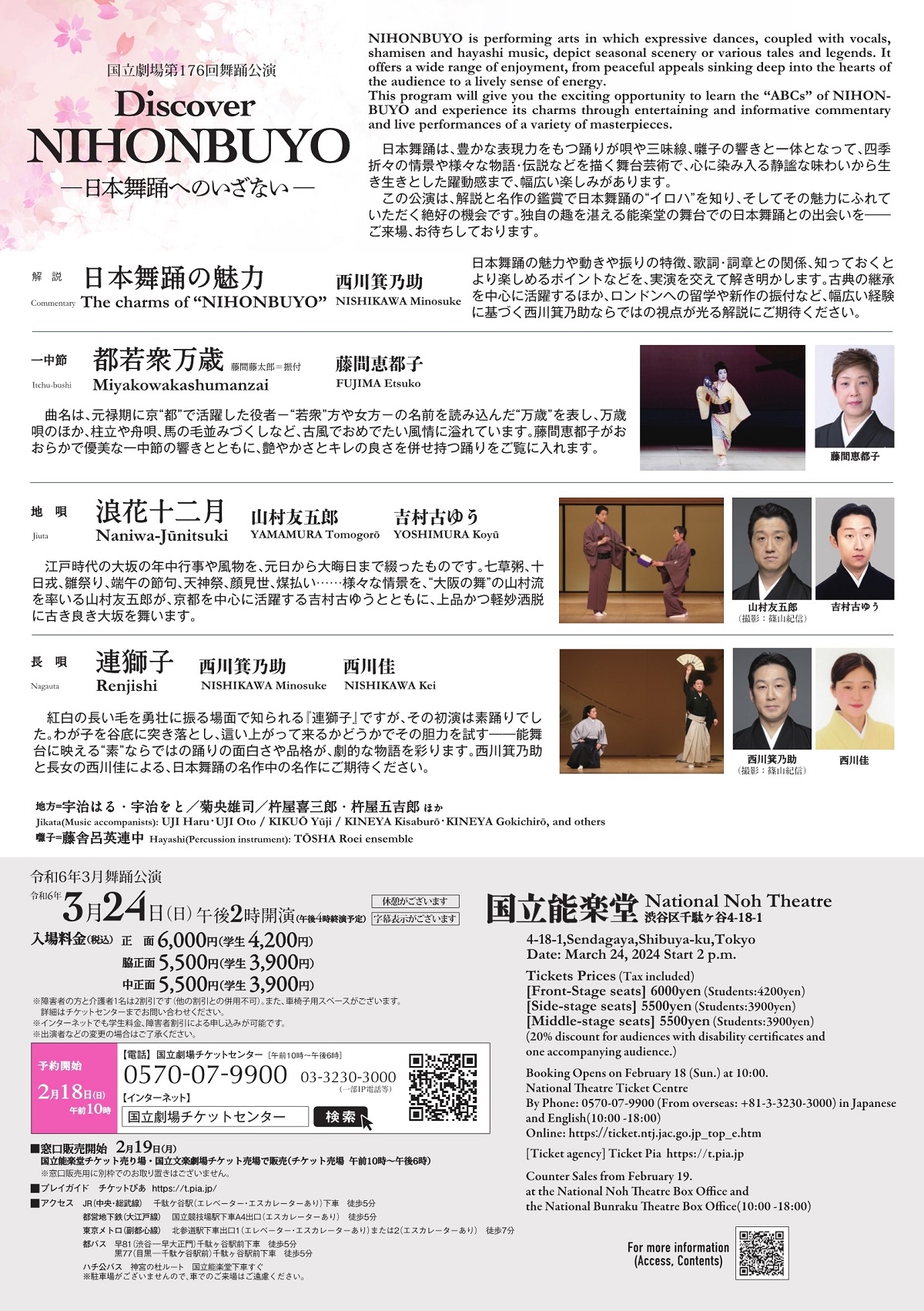- Others
- Other Theater
Traditional Japanese Dance
National Noh Theatre
Discover NIHONBUYO
*Please note that this is NOT a Noh performance, even though it is taking place in the National Noh Theatre.
Performance Date
March 24(Sun.), 2024
Performance Time
2:00 p.m. - 4:00 p.m.
* End time is an estimate and may vary.
Commentary
The charms of “NIHONBUYO”
Nishikawa Minosuke
Itchū-bushi
Miyakowakashumanzai
Fujima Etsuko
Jiuta
Naniwa-Jūnitsuki
Yamamura Tomogorō
Yoshimura Koyū
Nagauta
Ren-jishi
Nishikawa Minosuke
Nishikawa Kei
Jikata (Music accompaniment):
Uji Haru・Uji Oto
Kikuō Yūji・Kineya Kisaburō・Kineya Gokichirō and others
Hayashi (Percussion instrument):
Tōsha Roei ensemble
*Audio guide : Not available.
*Subtitles: Available in English and Japanese. Displayed on individual screens on front seat backs.
*English synopsis is available. It is included in the free Japanese brochure.
Tickets(Tax included)
[Front-Stage seats] Adults: 6,000 yen (Students: 4,200 yen)
[Side-stage seats] Adults: 5,500 yen (Students: 3,900 yen)
[Middle-stage seats] Adults: 5,500 yen (Students: 3,900 yen)
Seating plan
Booking Opens
10:00.a.m.,February 18 (Sun.), 2024
*Tickets for students and persons with disabilities for this performance are available online.
*20% discount for audiences with disability certificates and one accompanying audience.
-----------------------------------------------------------------------------
Box Office
0570-07-9900 (From overseas: +81-3-3230-3000) in Japanese and English (10:00 a.m. - 6:00 p.m.)
https://ticket.ntj.jac.go.jp/top_e.htm
-----------------------------------------------------------------------------
Counter Sales at the Theatre
available from February 19 (Mon.), 2024 at
the National Noh Theatre Box Office and the National Bunraku Theatre Box Office (Business hours: 10:00 a.m. - 6:00 p.m. )
NIHONBUYO is performing arts in which expressive dances, coupled with vocals, shamisen and hayashi music, depict seasonal scenery or various tales and legends. It offers a wide range of enjoyment, from peaceful appeals sinking deep into the hearts of the audience to a lively sense of energy.
This program will give you the exciting opportunity to learn the “ABCs” of NIHONBUYO and experience its charms through entertaining and informative commentary and live performances of a variety of masterpieces. It is an encounter with NIHONBUYO at the National Noh Theatre stage that offers its own very special appeal. We look forward to your visit!
Commentary: The Charms of NIHONBUYO
This demonstration illuminates the charms of NIHONBUYO; you will gain a greater understanding of the characteristics of the performers’ body movements and choreography, the relationship between the dance moves and lyrics, as well as some enlightening and interesting pointers to help you enjoy the performances even more. We are pleased to bring you brilliant commentary from the viewpoint of NISHIKAWA Minosuke, which is backed up by his extensive experience in the traditional Japanese performing arts, including engaging in the continuing succession of the classics, studying abroad in London, and creating the choreography of new works.
Itchū-bushi: Miyakowakashumanzai
With the title of the song representing manzai featuring the names of actors – wakashu (a young male) and onnagata (actors who play female roles) – who flourished in Miyako, the ancient capital of Kyoto in the Genroku period, this piece is full of the antiquated, auspicious tastes of the day, such as hashiradate (a pillar set-up ceremony for a new house), funauta (a boatman’s song) and uma no kenamizukushi (the many kinds of fine, shiny coats on a horse) in addition to manzaiuta (a strolling musicians’ song). Fujima Etsuko performs a dance highlighting both coquettishness and crispness to the serene, elegant sounds of Itchū-bushi.
Jiuta: Naniwa-Jūnitsuki
This piece depicts the annual events and customs in Osaka during the Edo period, as observed from New Year’s Day to the last day of the year. Rice porridge with the seven spring herbs, the Ebisu Festival of the Imamiya Ebisu Shrine, the Doll Festival, the Iris Festival, the Tenjin Festival, the season’s first performance with an all-star cast, and a year-end thorough cleaning to welcome the New Year, and many other scenes are featured. The colorful sceneries are expressed by YAMAMURA Tomogorō, the head of Yamamura School known as the “dance of Osaka,” who dances in the good old Osaka style in an elegant yet light and fashionable manner together with YOSHIMURA Koyū, who actively performs mainly in Kyoto.
Nagauta: Renjishi
Renjishi, known for the scene in which the father and son lion spirits valiantly shake their long red and white manes in tandem, was first performed as a Suodori (dance without adornment) piece. A father lion pushes his cub over a ravine into a deep valley, waiting anxiously to see if his son has the guts to climb back up – the unique appeal and style of this un-costumed dance shining out on the Noh Theatre stage adds its own flair to this dramatic tale. We invite you to experience this “masterpiece of masterpieces” performed by NISHIKAWA Minosuke and his eldest daughter, NISHIKAWA Kei.


